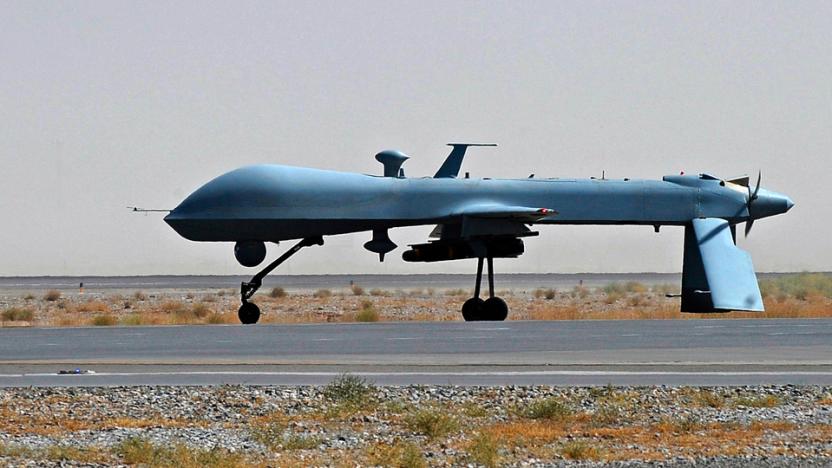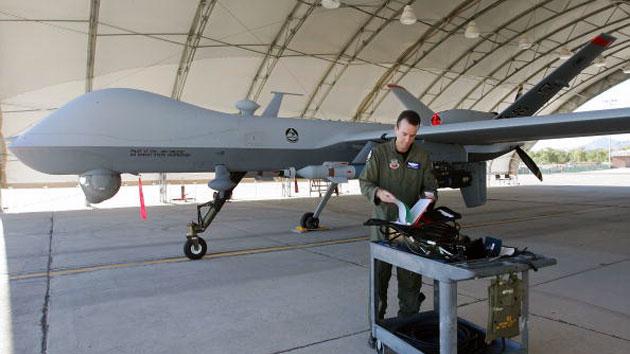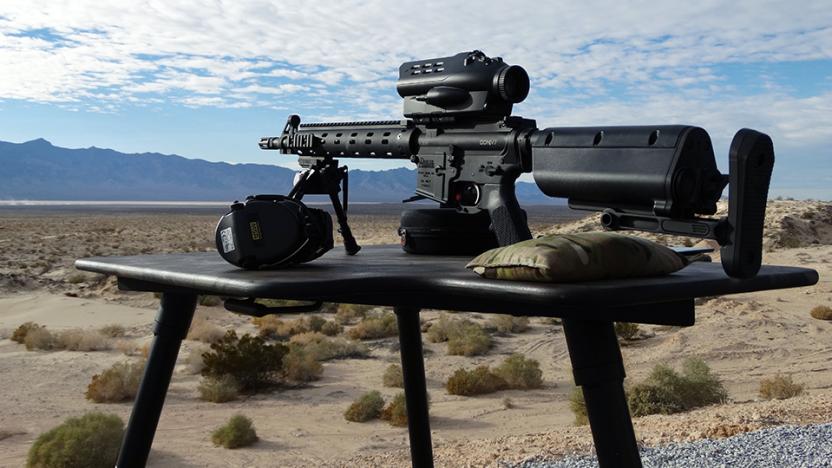wargadget
Latest

DARPA wants to build vehicles that disappear after delivering supplies
What if the vehicle delivering the goods to a remote village or group of soldiers could just vanish after it made the drop? Sounds crazy, right? Well, DARPA is hoping to do just that. The research unit it looking to develop solutions that can carry supplies to their intended destinations and then disappear. Named for the story of a man who's wings of feathers and wax melted when he flew too close to the sun, DARPA's new ICARUS program that'll examine the possibilities is an extension of its VAPR project. Of course, we expect DARPA is aiming for a more positive outcome. VAPR, which stands for Vanishing Programmable Resources, has developed self-destructing electronic components since it began two years ago. Aside from the obvious military uses, DARPA says a vehicle that vanishes in to thin air could also offer an unmanned solution for taking critical supplies to hard to reach areas in the aftermath of events like a natural disaster. Once the load is delivered, personnel wouldn't have to worry about getting the vehicle back out of the area. [Image credit: SEBASTIEN BOZON/AFP/Getty Images]

DARPA wants to launch and land Gremlins on moving planes
DARPA wants to transform airplanes into drone carriers. Last year, the agency invited technical ideas and business expertise to help create a reusable airborne system. Today, it announced the launch of the Gremlins program that's designed to make that air-recoverable unmanned system a reality. According to Dan Patt, program manager at DARPA, the "goal is to conduct a compelling proof-of-concept flight demonstration that could employ intelligence, surveillance and reconnaissance (ISR) and other modular, non-kinetic payloads in a robust, responsive and affordable manner."

Hawking, Musk and others call for a ban on autonomous weapons
If you don't like the thought of autonomous robots brandishing weapons, you're far from alone. A slew of researchers and tech dignitaries (including Elon Musk, Stephen Hawking and Steve Wozniak) have backed an open letter calling for a ban on any robotic weapon where there's no human input involved. They're concerned that there could be an "AI arms race" which makes it all too easy to not only build robotic armies, but conduct particularly heinous acts like assassinations, authoritarian oppression, terrorism and genocide. Moreover, these killing machines could give artificial intelligence a bad name. You don't want people to dismiss the potentially life-saving benefits of robotic technology just because it's associated with death and destruction, after all.

Lockheed Martin buys helicopter maker Sikorsky
Don't look now, but Lockheed Martin just became an even larger aerospace powerhouse. The aircraft maker has acquired helicopter maker Sikorsky (best known for the UH-60 Blackhawk) for $9 billion. The two have already been partners on programs like the MH-60, but this gives Lockheed its very own rotary-wing team. If a customer wants something that flies, the company will have it covered. The buyout is poised to close by late 2015 or early 2016, provided everything goes smoothly.

Boeing and Hacking Team want drones to deliver spyware
Forget safeguarding drones against hacks -- if Boeing and Hacking Team have their way, robotic aircraft would dish out a few internet attacks of their own. Email conversations posted on WikiLeaks reveal that the two companies want drones to carry devices that inject spyware into target computers through WiFi networks. If a suspect makes the mistake of using a computer at a coffee shop, the drone could slip in surveillance code from a safe distance.

Army exoskeleton prototype helps soldiers learn to shoot
Foot soldiers thrive on their shooting skills, but learning expert marksmanship can take a long, long time. US Army researchers could soon have a robotic shortcut to improving those skills, however. They're working on MAXFAS, an arm exoskeleton that uses cable-activated arm braces to correct involuntary arm shakes while you're shooting -- think of it like a stabilized camera. The carbon fiber body is light enough that it doesn't weigh you down, and it's smart enough to detect the differences between purposeful movements (such as aiming) and tremors.

The US military is developing Star Wars-style hoverbikes
Last time we heard from Malloy Aeronautics, it was testing hoverbike technology with a robot-carrying drone. A few months later, it's partnering with a Maryland-based defense company to develop a hoverbike for the US military. Working with Survice Engineering Co., the UK aeronautics company will set up shop in Maryland as part of "an ongoing research and development contract." The duo will also work with the US Army Research Laboratory on the project that aims to create "a new class of Tactical Reconnaissance Vehicle (TRV)."

US military tests a Tinker Bell-sized drone
There's no standard set for the shape or form of drones, and the Army plans to use that to its advantage. Here's where the Black Hornet Nano comes in. This micro drone, designed by Norway-based firm Prox Dynamics, is small enough to fit in the palm of your hand, measuring in at a mere 4 x 1 inches and weighing only around 0.04 lbs. What's more, the PD-100 UAV features regular as well as thermal cameras and has a range of roughly 0.6 miles -- in other words, it's perfect for those missions that require stealth surveillance.

The US Navy wants to protect its drones against hacks
Cyberwarfare is bad enough by itself, but it's especially dangerous when military drones are involved. The last thing you want is a hijacked UAV that can give away your position or, worse, fire on your own troops. To that end, the US Navy is asking private companies for help with developing technology that protects drones, missiles and other airborne weapons against hacks. Whoever has the best proposal will (hopefully) craft systems that not only prevent enemies from getting in, but bounce back quickly if the worst happens.

US Navy fighter jets will carry an autonomous anti-ship missile
The US Navy may have a robotic ace in the hole when it fights enemy warships in the future. It's planning to put Lockheed Martin's autonomous LRASM (Long Range Anti-Ship Missile) on the F/A-18 Super Hornet by 2019, giving jet fighters a weapon that tracks and wipes out targets mostly or entirely on its own. Most of the missile's details are secret, but it's smart enough to dodge obstacles on the way to vessels as far as 200 nautical miles out -- and that's the unclassified range, which suggests that it's more capable in practice. There are also versions of LRASM in the works that will launch from ships, submarines and other aircraft, so this intelligent projectile could soon be a mainstay of the US military.

The US' drone pilots aren't getting enough training
The US is increasingly relying on drones for recon and air support, but you almost wouldn't know it from how little training those drones' pilots get. A Government Accountability Office report has revealed that both Air Force and Army crews frequently have a tough time getting enough flight hours to stay current. Many Army pilots find themselves being assigned menial tasks that keep them from their main role, ranging from guard duty to mowing the lawn. Air Force operators on the front lines have no problems getting experience at the controls, but they're often limited to whatever combat missions they can fly. The USAF only has about 85 percent of the qualified pilots it needs to be truly effective, according to the report.

Duck-like US Navy drone can fly or swim to hunt submarines
There are plenty of flying and swimming drones, but you'd ideally have both at once for sub-hunting -- you want something that can poke its head underwater, but move quickly through the air when needed. The US Navy certainly knows this. It's developing a duck-like drone, the Flimmer, that can both fly and swim. In addition to both a rear-facing propeller and wings, its latest incarnation has four fins that adapt to what the robotic craft is doing. In flight, they serve as stabilizers and canard wings; in the sea, they flap to give the machine a speed boost.

US allows widespread exports of armed drones to its allies
The US has unsurprisingly kept a tight lid on sales of armed drones to prevent the technology from getting into the wrong hands, but it's about to loosen up... to a degree. The Department of State has introduced an export policy that clears the way for selling weaponized drones to allied countries. These partners must agree to use robotic warplanes according to certain principles; the machines are for national defense, not crushing internal political dissent. Nations also have to make a strong argument for why they truly need armed drones, and the US reserves the right to monitor usage, train crews or both.

Shooting a laser-guided rifle made me feel like a robot
By all accounts, I shouldn't have hit the dummy target 300 yards downrange because everything was working against me. For starters, the Las Vegas desert was windy as hell. Factor in that I was shaking thanks to nerves, cold temperatures and the pressure of a camera rolling while I tried something brand-new and you have a recipe for failure. Or should have. While I can barely pull off a headshot in a video game, I nailed one on my first try with TrackingPoint's high-powered, precision-guided rifle. Once the initial wave of "Holy shit!" wore off, something else replaced my elation: I didn't feel I'd earned that bull's-eye because basically all I had to do was pull the trigger. On my way back into Sin City, I couldn't get over just how cold and emotionless that left me feeling.

China has a microwave pain weapon of its own
The US may never have used its microwave pain gun in combat, but that isn't stopping China from exploring the concept of non-lethal force. Local manufacturer Poly has unveiled the WB-1, a millimeter-wave weapon that heats the water under your skin (much like the US' Active Denial System) to deliver intense agony without injury. It currently works at a relatively short range of about 262 feet, but extra power can bump that up to 0.6 miles -- if you know where to shoot, you could cause misery from afar. It's reportedly meant to be used on the high seas, where it could enforce China's territorial claims without the need to capture or destroy wayward vessels.

US Navy puts its first laser weapon into service
It's official: the US Navy has entered the future. Vice Admiral John Miller tells Bloomberg that the USS Ponce, an amphibious transport, has been using the Navy's Laser Weapon System (LaWS) in the Persian Gulf since late August. The high-tech arsenal is no threat to larger vessels, but it's potentially ideal for defending against Iran's fleet of smaller ships. The Ponce can use non-lethal laser flashes to spook enemies or thwart their sensors, and it can destroy small craft (including airborne drones) if they don't heed warnings. It'll take some time before laser weapons are a common sight on the high seas, since the Navy wants to know how it fares in real-world conditions; dust, heat and other Gulf conditions could lead to failures. If it pans out, however, there's a real chance that the days of conventional small deck guns are numbered. [Image credit: John F. Williams/US Navy, Flickr]

China will use lasers to take down low-flying drones
In order to defend itself against small drones, China built a laser-based system that can shoot down the compact aircraft up to 1.2 miles away. According to the official Xinhua news agency, the tech can bring down the rogue flying machines within five seconds of locating them at altitudes of up to 500 meters (1,640 feet). It's said to be effective against the small UAVs flying at speeds of up to 112 MPH, and will primarily be used to secure events in urban locales and lock down unauthorized mapping efforts. The new system can be installed on existing vehicles to ensure troublemakers and their drones are kept from causing any mayhem. In statement by the China Academy of Engineering Physics (CAEP), tests of the laser-based setup showed a 100 percent success rate, shooting down more than 30 drones during the trials. The CAEP is working on more robust systems with longer range as well. [Image credit: Fabrice Coffrini/AFP/Getty Images]

Tiny tethered drone gives soldiers a view of the dangers ahead
Drones already give troops valuable data about enemies and devastated areas, but the existing vehicles have their limits; big aerial drones can't see inside buildings, and their ground-based counterparts can't get over rough terrain. Well, CyPhy Works might just have reached a happy balance between those two extremes. It recently signed a deal with the US Air Force to produce the Extreme Access Pocket Flyer, a very tiny UAV (it weighs just 2.8oz) that sends HD video to soldiers for up to two hours. The key to its portability is a 250-foot microfilament tether that delivers both power and data -- bulkier gear like batteries will stay with the soldier. This has the upshot of adding reliability and security, since there's no wireless signal subject to interference or jamming.

Think tank hires 'Call of Duty' game director to predict the future of war
If you felt that Call of Duty: Black Ops II presented an eerily plausible vision of war in the years ahead, you're not alone. The Atlantic Council, a political think tank, has asked Black Ops II director Dave Anthony to contribute to an "Art of Future Warfare" project that looks at fiction as a possible insight into next-generation conflicts. As he explains, the next big threat to the US probably doesn't fit into conventional definitions of war -- a game developer can imagine fantastic scenarios that might just come true, such as Black Ops II's drone assault on a G20 meeting. This isn't the same as directly guiding US policy, so Anthony's effect will likely be limited. However, it won't be surprising if the country is eventually better prepared for high-tech terrorists and other dangers that it otherwise wouldn't have anticipated.

Lockheed Martin's 360-degree laser turret gets cleared for take-off
Lockheed Martin has an affinity for lasers -- that much is apparent. Not satisfied with simply having ground-based energy weapons, though, the outfit has recently tested its airplane-mounted death ray over the skies of America's High Five, Michigan. The Aero-optic Beam Control (or ABC, as its friends are fond of saying) was recently run through its paces to prove airworthiness, among other things. The kicker here is that the laser can rotate 360 degrees and eliminate targets from basically any direction. Yeah. Lockheed says that the turret's been designed to engage bogies at basically any position and there's tech in place to counterbalance any turbulence caused by the protruding sphere (pictured above). The trials aren't done just yet however, and they'll only increase in complexity to further prove the system's military-aircraft mettle as time wears on. So, you know, enjoy hiding out in your secret lair while it lasts.




